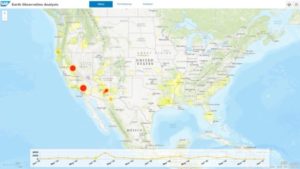SAP, in cooperation with the European Space Agency (ESA), has announced the Earth Observation Analysis service, a cloud service powered by the SAP HANA platform.
The two organisations have been working together since early 2016, facilitating access to a new field of opportunities in the geospatial context. They have done this by combining the HANA with ESA’s Earth observation data, especially from the Copernicus program.
Reinsurance company Munich Re showcased its use of the Earth Observation Analysis service for predicting potential future impact from historic and current data at SAP’s TechEd conference in Barcelona.
showcased its use of the Earth Observation Analysis service for predicting potential future impact from historic and current data at SAP’s TechEd conference in Barcelona.
“Every year, wildfires affect nature, people, their homes and businesses,” said Andreas Siebert, head of Geospatial Solutions, Munich Re. “While the progress of a fire itself is hard to predict, this new service from SAP, leveraging satellite data from ESA, allows us to accurately calculate costs and risks related to wildfires and even gain insights into the future probability of wildfires. This will help us to keep costs down for our clients.”
The Earth Observation Analysis service provides a standardised interface for quick, easy consumption of detailed analytics and clusters them according to customer needs.
Based on continuous access to historical and real-time satellite data from around the world, organisations will seemingly be able to make improved business decisions concerning industry-specific questions.
These issues may include where to place new power lines or when to harvest crops.
“Our partnership with ESA paves the way to a new field of geospatial business applications, making it possible to close the gap between traditional Earth observation and a digitalized business world,” said Dr. Carsten Linz, business development officer and global head, Centre for Digital Leadership, SAP. “That opens a bright future for space-related applications, such as digital farming, gas pipeline management, and the improved planning of smart cities – bringing businesses to a competitive edge, creating new high-tech jobs and improving peoples’ lives.”





